“…born in a mansion and died in a shack…”
– from A Fierce Green Fire by Marybeth Lorbiecki
Buenos Aires – I’ve been to the barrio of Barracas (literally “shacks”) before, but always with a particular destination in mind. A friend suggested we take a real wander through the neighborhood – perhaps over time more than one, and we started off with a simple approach, printing out the city government’s self-guided walking tour – a good intro to many of the barrios in the city (a click of a button in the upper right corner and you can change the printout to English or Portuguese). They’re not detailed, by any stretch of the imagination – they tend to give a couple of sentences on each of maybe two dozen sites of interest – but it’s enough to take you on an interesting wander through an area – you’ll spot things on your own that aren’t included. Much of what they government tends to think will be interesting are sites where someone famous in the government world once lived or worked, or major companies that once were, or still are, king of the sandpile in their particular field.
In fact, the tour of Barracas begins with a former major cookie factory, segues in the middle to the remains of a major clothing manufacturer, and at roughly the endpoint is a former chocolate producer. On the way, you pass down streets where you are assured that once upon a time, the rich and famous and powerful lived. It’s a little hard to see that in this part of the barrio – what at one time were the quintas or mansions and grounds of some of the wealthiest families in the early years of the city, changed radically after the yellow fever epidemic of 1871, when those families headed for areas away from the river and neighboring areas where poor immigrants lived. The barrio became a collection of shacks – hastily erected structures – which housed the workers for the docks and factories that also began moving into the area. Today, most of that, at least in the part of Barracas that the walk guides you through, is a strange mix of old one and two family buildings of anywhere from poor to high quality construction, but nothing overly fancy, lots of churches, factories, and the blight of a zone that has no historic edifice protections – ugly apartment towers.
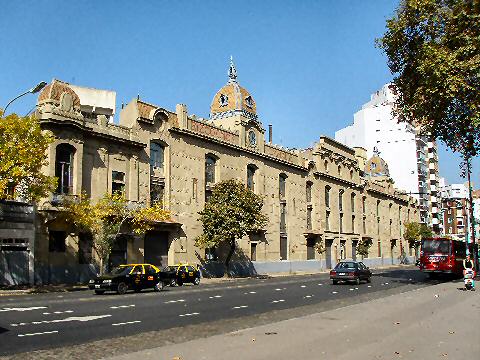
The tour starts just off of Parque Lezama in San Telmo, at the point where San Telmo, La Boca, and Barracas all come together. It heads down Av. San Martín and after a short strip of gas stations and McDonald’s, reaches the former cookie factor of Canale, which once, apparently “perfumed the entire barrio”. Poetic, if unlikely, given the size of the barrio and the stench of the waterfront…
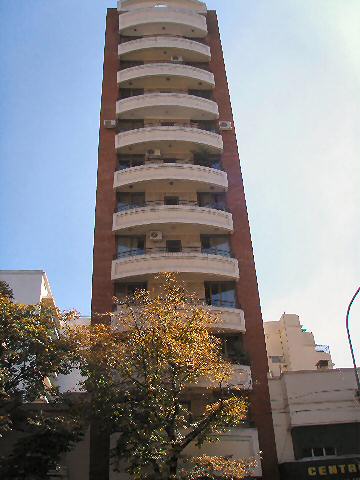
In the midst of one and two story homes and businesses, every block seems to have one or two apartment buildings jutting up like the proverbial sore thumb. The worst part, with most of them, is that some architect and some owner actually came to agreement on a set of plans for these, looked at them and said, “oh yeah, that looks good… and so in keeping with the neighborhood…”.
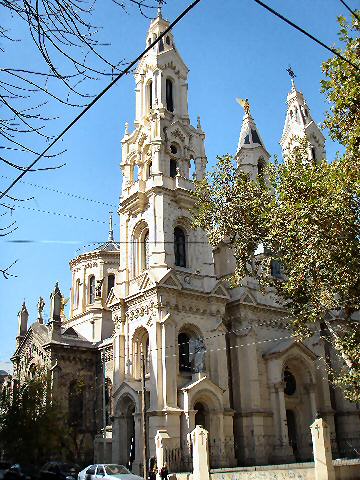
Amongst the many churches in the barrio, this one stands out for its stunning gothic influenced architecture, multiple chapels, and, most interestingly, it wasn’t built by the Catholic Church, but by the parents of a young woman who was assassinated by a spurned would-be lover. Many of the statues that grace the church are of secular figures who were part of the story, rather than the usual saints and prophets and such. The church has guided tours on Sundays at 11 a.m…. one of these days it will be interesting to go back for that… there’s a gated grotto in the churchyard that looks like it might be the mausoleum for the young lady herself.
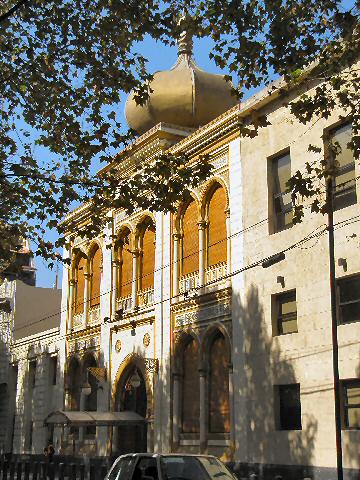
In the middle of a tree-lined street nearby is the surprising architecture of the Templo Israelita Or Torah, an orthodox, sephardic synagogue, with an onion dome, ornate doorways, and from a quick glimpse we were allowed of the inside, gorgeous Andalusian tiled mosaics in the entry foyer and a courtyard. Because of the Passover holiday no tours were being offered, but we were told we could call after this week and arrange for a tour. That’s a definite one to put on the list!
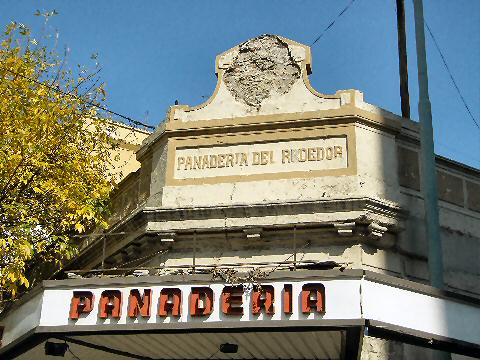
This old bakery caught my eye – clearly there for a long time, and I kind of like the juxtaposition of the old cast concrete sign with the “modern”, though still clearly fairly old, marquee sign.
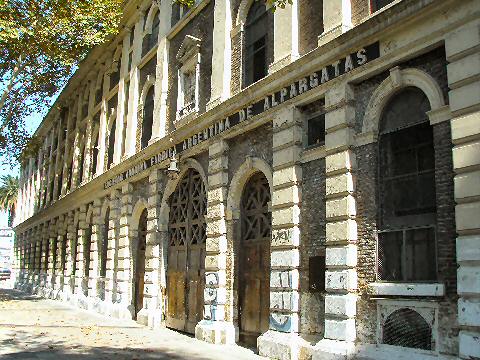
The tour continues to the site of what is/was one of Buenos Aires’ most important textile manufacturers, Alpargatas. Strangely, or maybe not, given the odd sense of what’s important, the tour talks about the factory building – which is a huge, full city block, plain, dingy grey, concrete structure with its only notable feature a strangely out of place art deco style entrance. Much of the building appears to now be an outlet store for the textiles and clothing. Of more interest, and not mentioned, is the opposite side of the street, where stand the remains of the offices of the company, a building that was clearly far more ornate, and which now is nothing more than a facade, behind which is an employee parking lot and a couple of warehouses.
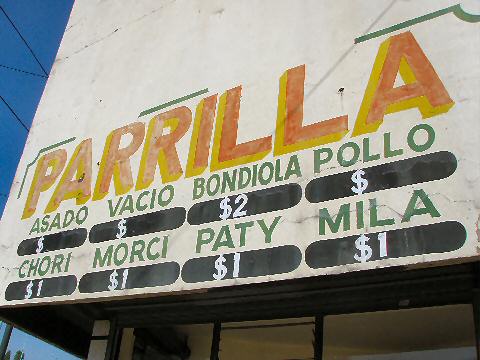
This local parrilla caught my eye – it’s little more than a lunch counter now with a couple of different sandwiches offered – at quite reasonable prices, no?
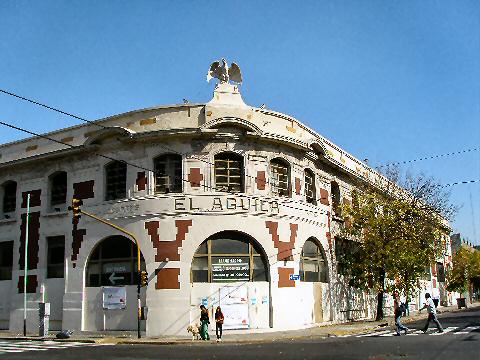
The former plant for the El Aguila (“the Eagle”) chocolate company, which still exists, though elsewhere. Most of this building has been converted to storage for the attached Easy store, more or less the local version of a Home Depot.
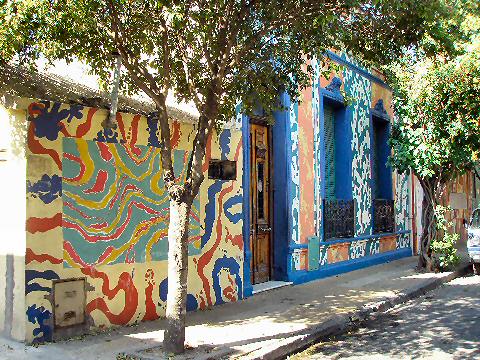
This was a fascinating find – I vaguely remember reading about this on a local travel site, though it didn’t really sink in at the time. This is a short, 3-block long narrow street (which the guide describes as a “sinuous alleyway”… I’m not sure that one 10° bend qualifies as sinuous, and it’s significantly wider than most alleys. A local artist, Marino Santa Maria, worked out a deal with the folks in the neighborhood (well, most of them, a few of the houses clearly had owners who didn’t go for the idea) to paint, tile, and in other ways decorate the homes along the street in interesting abstract swathes of color.
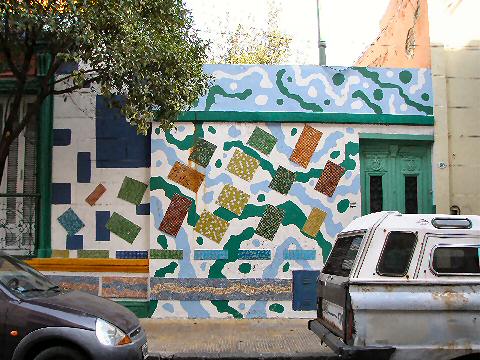
Each house is done up in a completely different fashion, which leads to a fun riot of color, that while perhaps not as striking (and not as easy to get to) as the Caminito in La Boca, which shows up on postcards and is a regular stop on local tours – mostly so that the guides can get a cut of the souveniers sold, is far more interesting for those with an eye for interesting street art to wander.
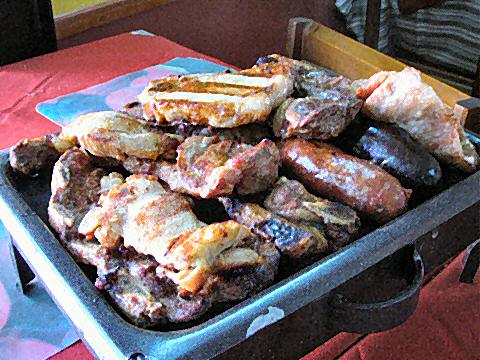
Conveniently located right at the end of the street, at the corner of Av. Suarez, is the parrilla Lanin, Suarez 1999, where we were served up one of the more jam-packed parrilladas for two that I’ve encountered – so much that between two of us we only made it through half, the rest we carted away – and roughly a mere 20 pesos apiece. Not only that, but it was really a very good mixed grill, with chorizo, morcilla, kidneys, intestines, steaks, pork chops, and ribs – well seasoned, and offered up with a decent, very garlicky chimichurri. The place attracts, at least during our lunch, a mix of local factory workers and businessmen, many of whom probably come there nearly daily for lunch. [Closed]
There’s a whole lot more to the barrio, which is actually one of the bigger ones in the city, than this short wander, but it was an interesting introduction to a portion of it….